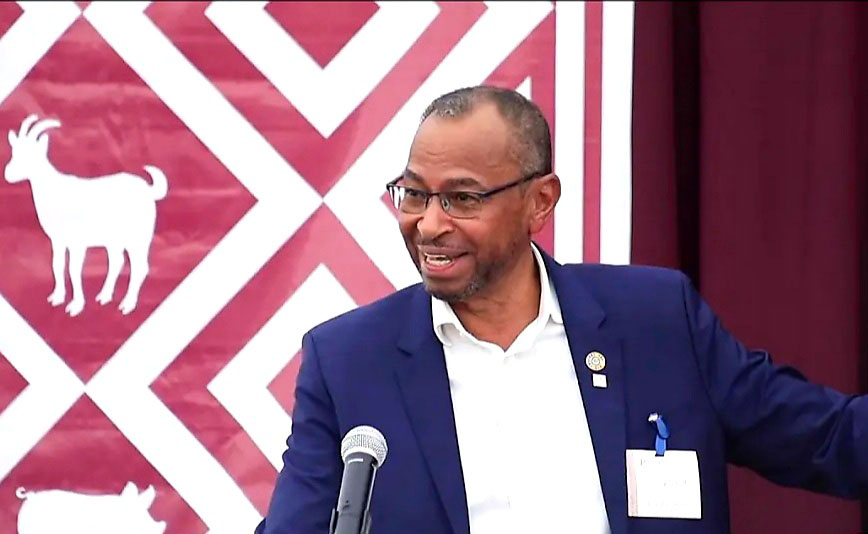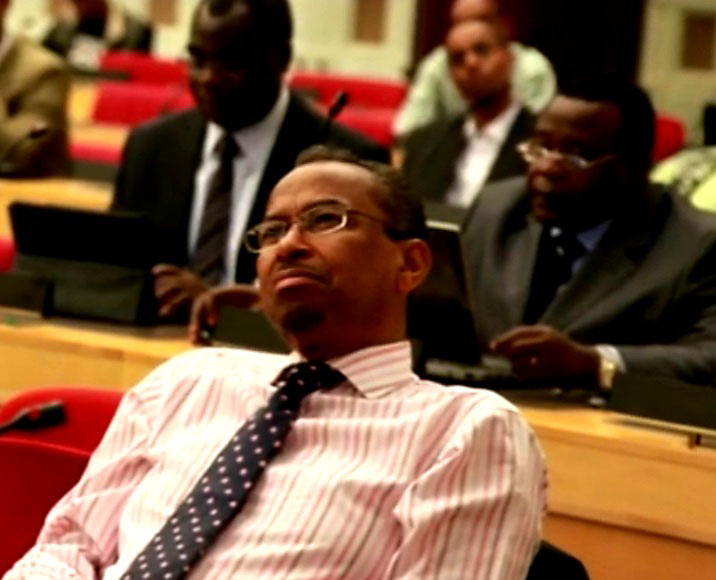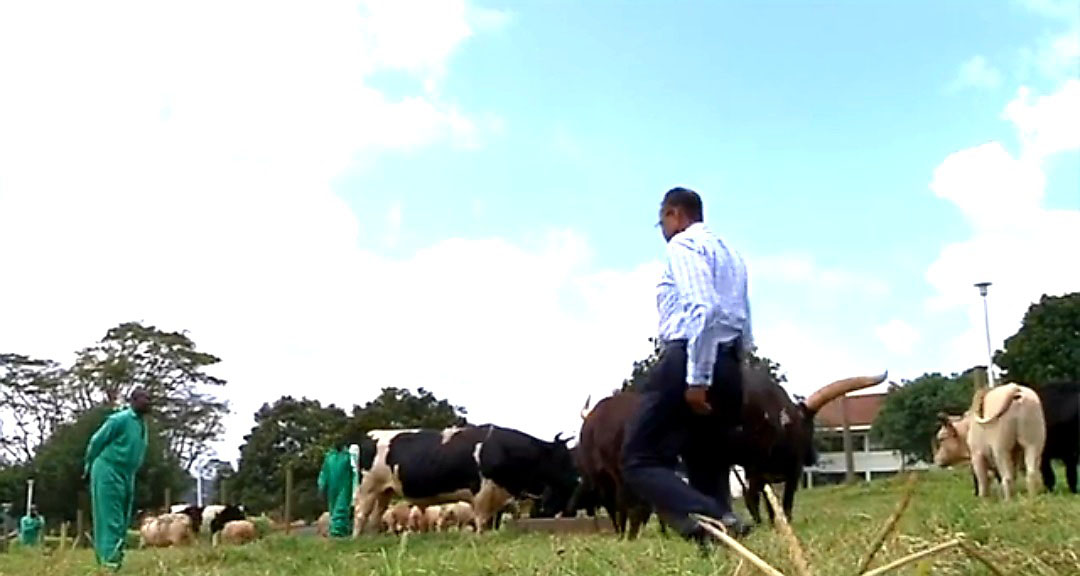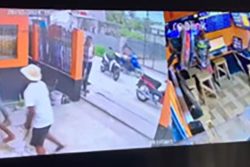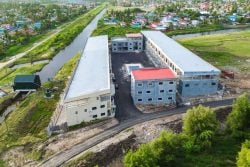By Miranda La Rose
Guyanese Canadian livestock specialist Dr James Wilson Smith, well-known as Dr Jimmy Smith, was admitted to the Guyana School of Agriculture (GSA) to pursue the certificate course in farm sciences with the objective of taking over the management of his father’s farm in the Berbice River. However, seeing young agricultural scientists while at the GSA in Mon Repos, made him want to pursue that path, so he did.
“I saw people who were young with bachelor’s and master’s degrees at the time at the Central Agricultural Station now NAREI [National Agricultural, Research and Extension Institute] and I wanted to be like them. GSA was next door to the agri station. The dorm I was in was an annexe to the main dormitory and it was in the compound of the agri station. Every day as I went to classes or to the dining hall, I passed the beautiful houses of these young agri scientists who had just come back with their degrees from the University of the West Indies. Some older guys like Dr B K Rai and Dr Ramdhin were there. Some taught at GSA so I met them there. They changed my orientation from whatever I was going to do,” Smith told Stabroek Weekend from his home in Maryland, USA. Smith is the director for International Programs in the College of Agriculture and Natural Resources, University of Maryland.
Smith had initially entered the GSA to pursue the one-year certificate programme in farm science on a College of Preceptors certificate. The New Amsterdam-born Smith had his secondary education at the then Victoria High School which folded before he could write the General Certificate of Education (GCE) Ordinary Level examinations. He then successfully wrote several subjects at GCE O’Level examinations in his first year at GSA to enable him to continue his studies in the diploma in tropical agriculture because he wanted to further his studies at the university level.
He was raised between New Amsterdam and the Berbice River where his parents owned a farm. “I spent time on the river when it wasn’t school. The farm influenced me to study agriculture. We were eight sons, no daughter. My older brothers were not interested in agriculture. They went on to do engineering and other professions. I was the only one who had an interest in farming. I looked after the animals. My father felt I was going to take over the farm. That was when I went to GSA from 1969 to 1971 to study scientific farming to take over my parents’ farm,” he said. That never happened.
The LIDCO experience
After graduating from GSA, Smith worked with the Ministry of Agriculture. While working he obtained a United States Agency for International Development scholarship to Tuskegee University, Alabama in 1976 where he studied animal and poultry sciences with a minor in crop science.
When Smith returned to Guyana, he worked with the Livestock Development Company (LIDCO) as a ranch manager at Arakaka, Region One (Barima/Waini). The LIDCO ranch was next to the GSA campus at Arakaka. He lived in Matthew’s Ridge and drove to the ranch every day. From Arakaka he was reassigned to develop the Moblissa dairy development project.
“I was in charge when they were putting in the milking machines, electrification and other works. Then I became head of LIDCO operations. I was in charge of all LIDCO ranches – Ebini, Mara, Pirara and Kabawer (Abary) and the milk processing plant in Georgetown,” he recalled. He was with LIDCO from 1977 to 1980.
He left LIDCO in 1980 to pursue a master’s degree and a PhD in Animal Sciences at the University of Illinois. While enrolled in the master’s and PhD programmes, Smith worked as a research and teaching associate at the university from 1980 to 1986 when he graduated with the PhD.
“I understand after I left LIDCO, the government sold its assets to a private individual who sold all the animals. I hear now they are trying to reinvest in Moblissa again. I spent a good bit of my youth working for LIDCO developing those ranches including Moblissa. One thousand milking cows, modern milking parlours, cooling systems. A few years later they weren’t there anymore. Ebini, a beautiful ranch with pedigree animals, dating back to pre-independence, sold to a guy who got rid of them. The whole station at Ebini went derelict. They started building it up over the last few years,” he said.
“I was one of those who returned to Guyana. I had a US government scholarship when I went to Tuskegee. I wasn’t obligated to return. When I did my PhD, I went on my own. I had no contract or bonding to return to Guyana but I did. I love Guyana. I love my roots. I come back every so often but I go straight to New Amsterdam and the Berbice River, visit friends and leave.”
On his return to Guyana after obtaining his PhD, Smith was appointed to head the Caribbean Agricultural Research and Development Institute (CARDI) in 1986 as the country representative and programme manager.
His main role was to build partnerships among governments in the region and with other regional organisations like the Caricom Secretariat, the Caribbean Development Bank and UWI.
“In Guyana, I recruited people like Nigel Cumberbatch, Courtney Bullen, Claude Wickham and Vernon McPherson to work on development research on the intermediate savannahs,” he said.
In 1991, on the invitation of a colleague Smith interviewed for and was appointed regional director with the International Livestock Research Institute (ILRI) in Nigeria, West Africa where he was responsible for both Anglophone and Francophone West Africa. Later on he assumed a similar position for the ILRI in Ethiopia with responsibility for eastern and southern Africa. After Ethiopia he worked with the Canadian International Development (CIDA).
“In the Caribbean when you hear about Africa, you think about people completely backward. There are poor countries in Africa but each country has its good and its bad, like everywhere else. But of course, Guyana is a country with less than a million people. That is a village in most African countries. Yes, there is a lot of rural poverty but there is also lots of development in Africa. I learnt that what we had in the Caribbean was not real poverty but sort of quality of life issues. The job in Africa was quite challenging. There was a lot of poverty,” he noted.
Culturally, he said, descendants of Guyanese who came from Africa were from West Africa. “In my genealogy, I didn’t know it at that time, some of my ancestors came from Ghana, Sierra Leone and Liberia from my father’s side. My mother’s side was more European. Africa made me more connected to the world. I saw a bigger picture and how interconnected the world was. For me Africa was a big learning experience,” he added.
Director general, ILRI
Before joining the University of Maryland, he served as director general of the ILRI, an entity of the Consultative Group on International Agricultural Research (CGIAR) system. The CGIAR comprises 12 agricultural research centres around the world with responsibility for different areas such as rice which is based in the Philippines or wheat and maize which is based in Mexico.
Smith headed the ILRI, which is based in Kenya and which has offices in 20 countries in Africa and Asia, including India, China and Vietnam, from 2011 to 2022. The institute’s mandate was to help developing countries develop and improve their livestock sector as an engine of growth and development. Its research focused on all the branches of livestock including, nutrition, health, veterinary services, economics, markets and trade.
At the ILRI, which has a staff of about 700 with a global budget of about US$110 million a year, Smith developed a ten-year strategy (2013-2023) for research development on livestock and mobilised funding, increasing it from US$44 million in 2011 to US$105 million in 2022. Among other initiatives, he mobilised US$2 million to develop and operationalise a world-class environment research centre on ILRI’s Nairobi campus to respond to global concerns about livestock and the environment. It is the only one of its kind in Africa, he said.
The position of director general has a two-term limit which Smith served and as he was winding up his second term and contemplating what next to do, he was invited by the leadership of the University of Maryland to work with the university in supporting its efforts to internationalise the work of the university.
Today, he said, “I’m trying to get the university’s faculty to contribute their expertise in research to science and technology not only in the US but in developing countries. So forming partnerships internationally where our faculty could do research in relation to food security, climate change etc, is crucial. It is also to attract foreign students to come to this university to study agriculture. I’m also responsible for the agriculture natural resource programme trying to get undergraduate and graduate students to come to the US and to get our students to go abroad on attachments,” he said.
Prior to working with the ILRI as director general, Smith was the manager for the Livestock, Agriculture and Rural Development Department of the World Bank in Washington DC from 2006 to 2011. That department essentially lends money or gives grants to the livestock sector of developing countries. It also looks at preventing zoonotic diseases.
His role was to make livestock funding a bigger part of the bank’s development financing to help developing countries to use livestock to aid in their development.
“Livestock is 40 percent agriculture GDP in most developing countries. Five of the top ten global commodities are livestock, so it is a very important area but it was quite neglected. My role in the bank was to raise the profile and provide more funding to the sector,” he said.
“Livestock has traditionally had a bad name in terms of the destruction of the environment and the eating of meat. Some of it is true. If you don’t manage livestock well, it could degrade the environment and if you eat too much of everything it is not good for you. It is not inherent that livestock is bad.”
While Smith was at the World Bank, the avian influenza struck in 2005/2006 and his department had to assist developing countries prepare to fight an outbreak.
“We developed a plan to help particularly the poorest developing countries to finance their fight against avian influenza. We worked with the World Health Organisation and the Food and Agricultural Organisation to fight that pandemic globally. That was just an emergency measure,” he related.
He said another wake-up call for the World Bank to do more in agriculture in developing countries was the 2008 World Food Price crisis where there was a shortage of some of the major grains because of the failure of production weather in some of the wheat and rice producing countries that drove food prices up.
“The rich use no more than five per cent of their income for food while the poor in developing countries use about 40 to 50 per cent or more of their income on food,” he noted.
During his tenure at the World Bank, Smith’s colleagues encouraged him to take up the director generalship at the ILRI which was a bigger job, in terms of international profile and reputation.
CIDA
Before joining the World Bank, Smith worked as principal policy adviser on agriculture and rural development with the Canadian International Development Agency (CIDA) in Ottawa, Canada from 2001 to 2006.
“At that time development funding or assistance for agriculture from development agencies was very low. On the whole, it was about 15 to 20 per cent for agriculture in the 1980s and 1990s then it precipitously declined from about 15 per cent to about 2.5 per cent. So agriculture, which is a very important area of development that deals with food security, health and other issues, was not getting the attention it deserved,” he noted.
One of his main goals at CIDA was to raise funding back from where it was. “I worked with the minister with responsibility for CIDA to set up policy for agriculture and rural development. We reversed the decline in funding. When I went to CIDA, the funding for agriculture was about Cdn$60 million a year. By the time I left, the policy authorised the agency to spend up to Cdn$500 million a year globally in agriculture and rural development. I tried to put agriculture and rural development back on the map. That I think was one of my strong accomplishments at the time,” he said.
Asked if his work at the ILRI, the World Bank and CIDA, were ever acknowledged by the Guyana government, Smith said, “Lots of countries congratulated me but I never got a message from Guyana at any time. Guyana has not owned me, even though I try to own it. I got an award from the Vietnamese government for my contribution to agriculture for my work at ILRI.”
In terms of Guyanese who were appointed to senior global positions, he said, “I think Dr Kenneth King and I were two Guyanese with the highest appointments outside of political appointments to international organisations. I’m not worried that Guyana doesn’t recognise me. I am more a citizen of the world.”
